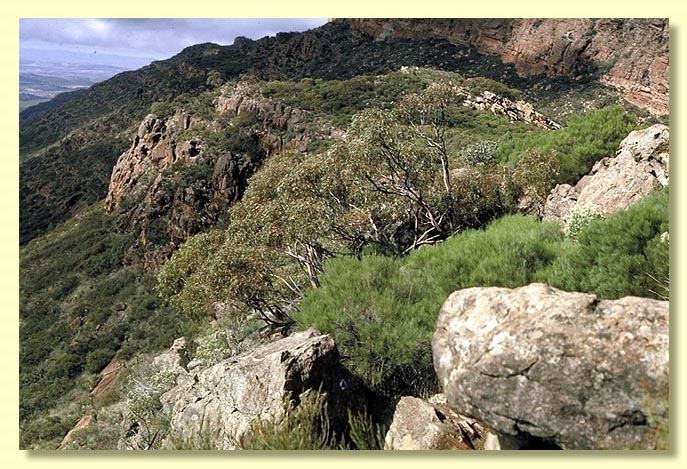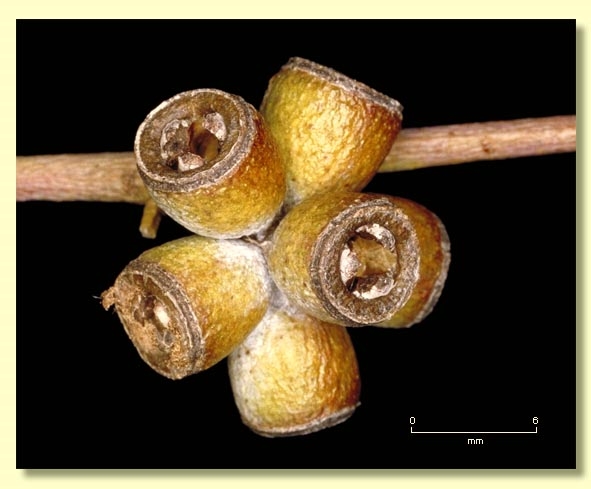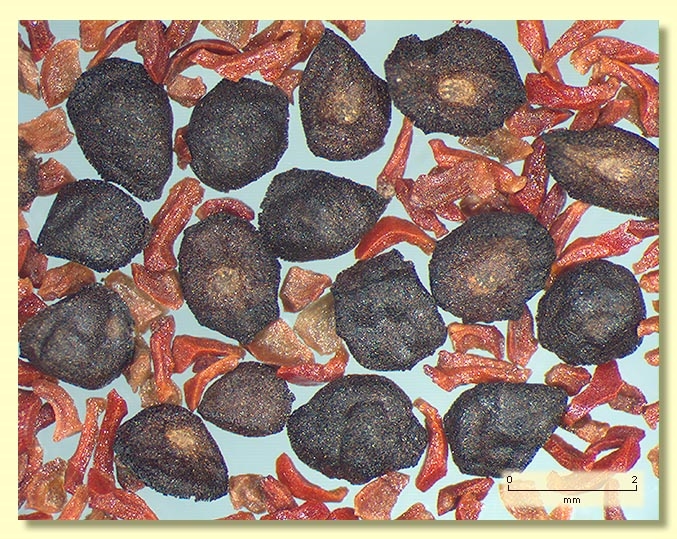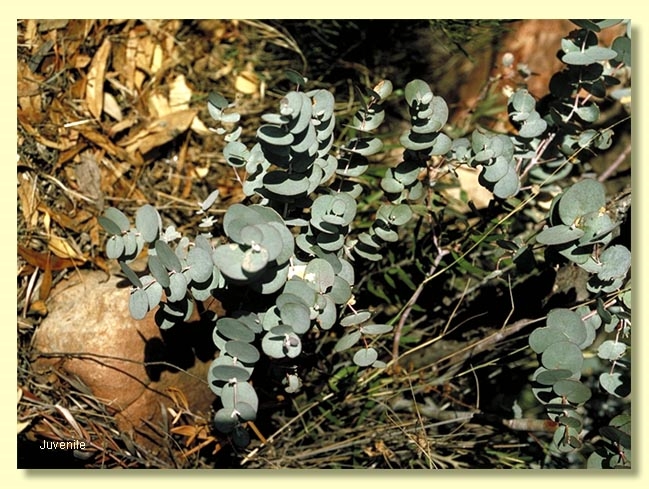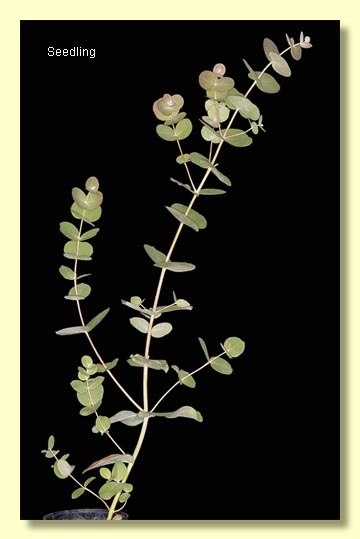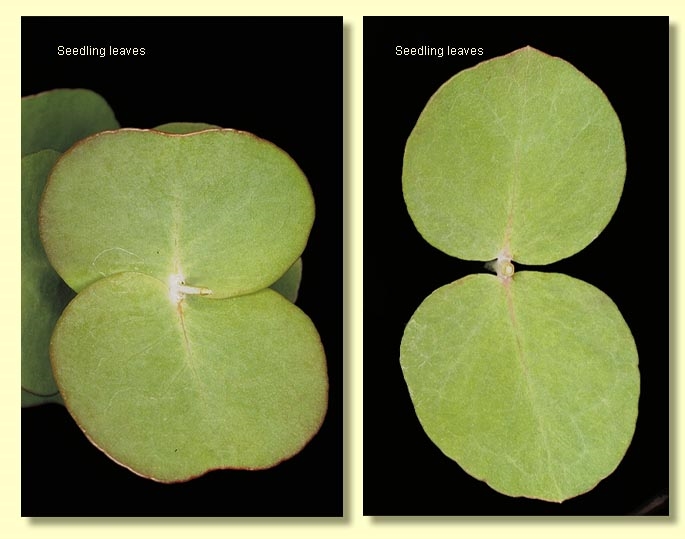Eucalyptus | Symphyomyrtus | Maidenaria | Euryotae | Globulares | Remanentes
Euclid - Online edition
Eucalyptus goniocalyx subsp. exposa
T: South Australia: Flinders Ranges Region: Tanderra Saddle, Wilpena Pound Range, 21 June 1997, D.Nicolle 1997; holo: AD; iso: CANB, NSW, PERTH (the CANB specimen not located at time of publication).
Bark rough, box-type and flaky for 1 to 2 m of stems then smooth, yellowish grey or whitish grey, or, on smaller plants smooth throughout.
Branchlets often glaucous (waxy).
Juvenile stems square or rounded in cross-section, glaucous; juvenile leaves opposite and sessile for many nodes, orbicular to ovate or cordate, 1.7–6.3 cm long, 1.7–4 cm wide, base amplexicaul to rounded or truncate, apex rounded or emarginate, glaucous.
Adult leaves alternate, petioles 1–2.2 cm long; blade lanceolate or falcate, 5.5–17.5 cm long, 0.8–1.8(2.1) cm wide, base tapering, margin entire, usually green, glossy, side-veins at an acute or wider angle to midrib, reticulation dense, intramarginal vein close to margin, oil glands island, yellow.
Inflorescence axillary unbranched, peduncles 0.5–1 cm long, buds 7 per umbel, pedicel to 0.1 cm long or buds sessile. Mature buds oblong, slightly angled, ca 0.7 cm long, ca 0.4 cm wide, scar present, operculum conical, stamens irregularly flexed, anthers oblong, versatile, dorsifixed, dehiscing by longitudinal slits, style long, stigma blunt, locules 3 or 4, the placentae each with 4 vertical rows of ovules. Flowers white.
Fruit sessile, cupular to cylindrical, 0.6–1 cm long, 0.6–0.9 cm wide, disc raised annular or descending, valves 3 or 4, near rim level or slightly exserted.
Seeds brownish black, 1.5–3 mm long, ovoid or flattened-ovoid, dorsal surface slightly roughened, hilum ventral.
Cultivated seedlings (measured at node 10): cotyledons bilobed; stems rounded to square in cross-section, glaucous, smooth or warty; leaves opposite and sessile for at least 20 nodes, orbicular or wider than long, 1.5–5 cm long, 1.5–6 cm wide, amplexicaul, glaucous over mid-green to grey-green.
Flowering time not recorded.
Eucalyptus goniocalyx is a small to medium-sized tree species found on tablelands and hills from the Northern Tablelands of New South Wales to central-western Victoria, also in South Australia in the Mt Lofty and Flinders Ranges, occurring as a mallee in the driest areas. The tree form has rough box-type bark on the trunk extending at least as far as the largest limbs and often to the smallest branches, but there is little or no rough bark on the mallee form. Adult leaves are always glossy green and buds and fruit are sessile in the axillary clusters.
In eastern Australia it is most likely to be confused with the often co-occurring E. bridgesiana but differs in the following ways: rough bark does not become tessellated, the orbicular juvenile leaves remain opposite for many pairs rather than becoming subopposite to alternate, and the buds and fruit are sessile. A related species, E. nortonii, occurs on poorer sites with shallow soil and differs by the glaucous adult leaves, buds and fruit.
The authors of EUCLID recognize three subspecies:
E. goniocalyx subsp. goniocalyx
Distributed south from Glen Innes and the Liverpool Range through the tablelands and western slopes of New South Wales, through the lower parts of the eastern highlands and the midlands of Victoria, both north and south of the Great Dividing Range, extending west to the Grampians and to near Diapur in the Wimmera district; and disjunctly in South Australia from the Mt Lofty Ranges as far as Mt Brown east of Port Augusta.
E. goniocalyx subsp. exposa
Found in the northern Flinders Ranges in South Australia where restricted to high exposed sites in the Elder range and Wilpena Pound Range. It differs from the other subspecies in being of poorer form, having much less rough bark, glaucous branchlets and not quite as glossy adult leaves.
E. goniocalyx subsp. viridissima
A Victorian endemic abundant on Mount Arapiles and also occurring in the northern Grampians at Mount Zero, near Halls gap, the northern Serra Range, and Red Rock in the Victoria Range. Subsp. viridissima can only be identified by its seedling and juvenile growth which have leaves strikingly mid-green and glossy, not glaucous like other subspecies. Elsewhere in Victoria botanists have collected this subspecies with its green juvenile growth: S of Wangaratta at 15-mile Creek and in Burrowa - Pine Mountain National Park. Seedlings raised from a population of trees of Eucalyptus goniocalyx subsp. goniocalyx at Mulligans Flat Nature Reserve, ACT, are occasionally green and glossy (non-glaucous) but more usually glaucous.
Eucalyptus goniocalyx belongs in Eucalyptus subgenus Symphyomyrtus section Maidenaria, a large group of species more or less restricted to south-eastern Australia, characterised by bilobed cotyledons, simple axillary inflorescences, buds with two opercula the outer of which sheds early in bud development, stamens with versatile anthers and flattened seeds with a ventral hilum. Within this section, E. goniocalyx belongs in series Globulares subseries Remanentes, having sessile, juvenile leaves opposite for many pairs on square stems, small buds in clusters of seven and small fruit usually with a descending disc.
Kevin Rule (2011) published three new subspecies of Eucalyptus goniocalyx, all endemic to Victoria. Subp. viridissima is included above, whilst the Rule's other two subspecies, viz. E. goniocalyx subsp. laxa Rule and E. goniocalyx subsp. fallax Rule, are regarded as plants of intermediate morphology between Eucalyptus goniocalyx and E. cypellocarpa.
subsp. exposa: English, exposed. The name has two intended meanings, the first referring to its exposed habitat on high altitude peaks and the second referring to the fact that until recently this taxon has been undescribed by botanists.

